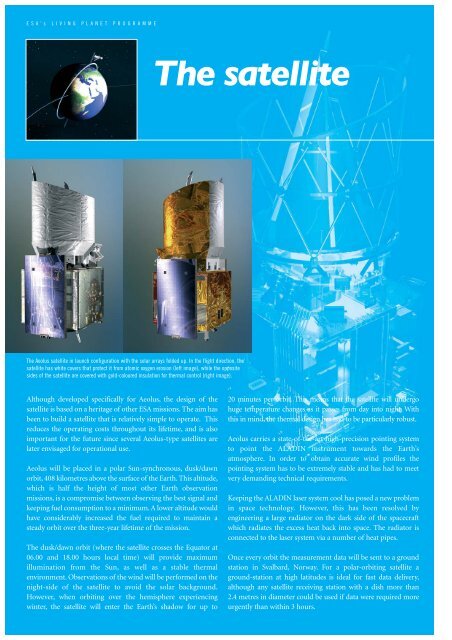ADM-Aeolus brochure (pdf) - ESA
ADM-Aeolus brochure (pdf) - ESA
ADM-Aeolus brochure (pdf) - ESA
Create successful ePaper yourself
Turn your PDF publications into a flip-book with our unique Google optimized e-Paper software.
<strong>ESA</strong>’s LIVING PLANET PROGRAMME<br />
The <strong>Aeolus</strong> satellite in launch configuration with the solar arrays folded up. In the flight direction, the<br />
satellite has white covers that protect it from atomic oxygen erosion (left image), while the opposite<br />
sides of the satellite are covered with gold-coloured insulation for thermal control (right image).<br />
Although developed specifically for <strong>Aeolus</strong>, the design of the<br />
satellite is based on a heritage of other <strong>ESA</strong> missions. The aim has<br />
been to build a satellite that is relatively simple to operate. This<br />
reduces the operating costs throughout its lifetime, and is also<br />
important for the future since several <strong>Aeolus</strong>-type satellites are<br />
later envisaged for operational use.<br />
<strong>Aeolus</strong> will be placed in a polar Sun-synchronous, dusk/dawn<br />
orbit, 408 kilometres above the surface of the Earth. This altitude,<br />
which is half the height of most other Earth observation<br />
missions, is a compromise between observing the best signal and<br />
keeping fuel consumption to a minimum. A lower altitude would<br />
have considerably increased the fuel required to maintain a<br />
steady orbit over the three-year lifetime of the mission.<br />
The dusk/dawn orbit (where the satellite crosses the Equator at<br />
06.00 and 18.00 hours local time) will provide maximum<br />
illumination from the Sun, as well as a stable thermal<br />
environment. Observations of the wind will be performed on the<br />
night-side of the satellite to avoid the solar background.<br />
However, when orbiting over the hemisphere experiencing<br />
winter, the satellite will enter the Earth’s shadow for up to<br />
The satellite<br />
20 minutes per orbit. This means that the satellite will undergo<br />
huge temperature changes as it passes from day into night. With<br />
this in mind, the thermal design has had to be particularly robust.<br />
<strong>Aeolus</strong> carries a state-of-the-art high-precision pointing system<br />
to point the ALADIN instrument towards the Earth’s<br />
atmosphere. In order to obtain accurate wind profiles the<br />
pointing system has to be extremely stable and has had to meet<br />
very demanding technical requirements.<br />
Keeping the ALADIN laser system cool has posed a new problem<br />
in space technology. However, this has been resolved by<br />
engineering a large radiator on the dark side of the spacecraft<br />
which radiates the excess heat back into space. The radiator is<br />
connected to the laser system via a number of heat pipes.<br />
Once every orbit the measurement data will be sent to a ground<br />
station in Svalbard, Norway. For a polar-orbiting satellite a<br />
ground-station at high latitudes is ideal for fast data delivery,<br />
although any satellite receiving station with a dish more than<br />
2.4 metres in diameter could be used if data were required more<br />
urgently than within 3 hours.

















